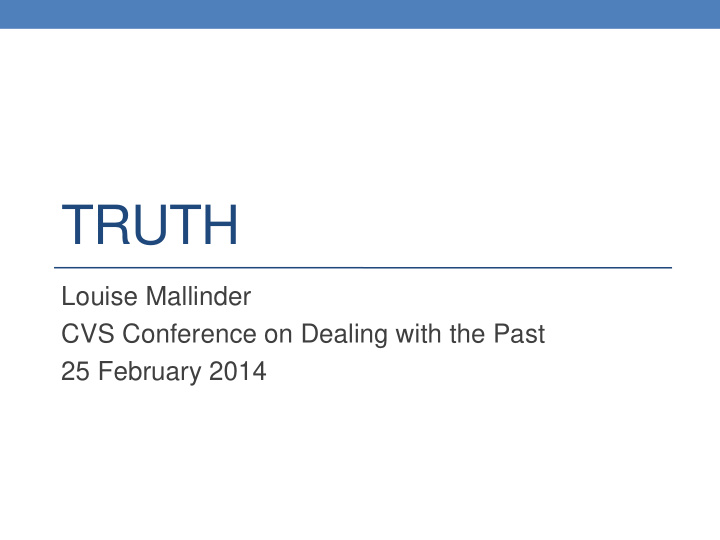



TRUTH Louise Mallinder CVS Conference on Dealing with the Past 25 February 2014
Presentation Overview • Who has a right to truth? • What types of information should be provided under the right to truth? • To what extent is the right to truth established in law? • What are the goals of truth recovery? • What processes can be used to provide truth?
WHO HAS A RIGHT TO TRUTH?
General Remarks • Right to truth is not mentioned explicitly in any international treaties • But it is viewed as emerging international law • This means that states have a duty to investigate international crimes and the most serious human rights violations (eg enforced disappearances, torture, violations of the right to life) • BUT the precise nature of the right is not clearly defined in binding international law
Right to Truth under the ECHR • Referred to GHRV triggering a ‘ right to know what happened’ for the victims, their relatives and the general public (eg El Masri v FYR Macedonia, 2012, para 191) • Found right to an effective remedy creates a duty on states to investigation violations of right to life, torture and disappearances • T o fulfil this obligation, investigations must be ‘Article 2 compliant’, i.e. • Effective • Independent • Prompt • Transparent
“Irrespective of any legal Truth as an proceedings, victims and their Individual Right families have the Updated Set of imprescriptible right to know Principles, Princ 4 the truth about the NB. This principles are ‘soft law’ standards meaning that they are circumstances in which not legally-binding violations took place and, in the event of death or disappearance, the victims’ fate .”
“Every people has the inalienable right to know the Truth as a Collective Right truth about past events concerning the perpetration of (Updated Set of Principles, Princ 2) heinous crimes and about the NB. This principles are circumstances and reasons that ‘soft law’ standards led, through massive or meaning that they are not legally-binding systematic violations, to the perpetration of those crimes. Full and effective exercise of the right to the truth provides a vital safeguard against the recurrence of violations .”
SCOPE OF THE RIGHT TO TRUTH
Content of Right to Truth • UN Study on the Right to Truth (2006) found it should entail investigating: • Causes leading to person’s victimisation • Causes and conditions pertaining to gross violations • Progress and results of an investigation • Circumstances and reasons for crimes • Circumstances in which the violation took place • For disappearances, fate and whereabouts of victims
Common Limitations on Uncovering Truth • Truth recovery processes only mandated to investigate certain crimes/periods/actors • Time, resource, personnel or legal constraints may restrict the types of questions that are asked by truth recovery processes • Problems with obtaining evidence of past abuses • Methods to record and analyse testimony may impact on the truth revealed • Reliance on testimony likely to produce multiple truths • Need for some form of immunity to get evidence from persons who might be liable for criminal prosecution, means that are often compromises to be made between truth and prosecutions • Whole truth of a conflict is impossible to obtain
TRUTH RECOVERY PROCESSES
Potential Objectives of Truth Recovery Processes • Discover and clarify facts about past abuses • Highlight institutional or social responsibility for violations • Provide formal acknowledgement to victims • Reduce conflict and denial over the causes and consequences of past violence • Contribute to holding individual offenders accountable • Recommend reforms • Facilitate reconciliation • Strengthen democracy and rule of law • Providing other assistance to victims, eg recommending reparations
Types of Truth Recovery Bodies • Truth commissions • International commissions of inquiry • International and national courts • Public inquiries • National human rights institutions • Ombudsmen • Traditional or informal justice processes • Official archives projects • Freedom of information bodies
Key Questions in Truth Recovery Design • What time period should a truth commission investigate? • What types of violations / patterns of victimisation should a truth commission investigate? • What level of information should a truth commission be expected to produce? • Should particular victim populations receive particular attention? • Should offenders receive any incentives to testify / protections against self-incrimination ie immunity? • How long should a truth commission operate? • How to balance aspirations with what a truth commission can realistically deliver?
Conclusions • Right to truth is emerging in international law from a range of sources, but much of it is not legally binding • Relevant legal obligations in NI come from Article 2 of the ECHR • Generally recognised that victims and societies have a right to truth for gross violations of human rights • Right to truth can entail investigations into facts of individual cases as well as patterns of violations, and cause and consequences of violence • Truth recovery processes have a range of individual and social goals designed address past abuses and prevent repetition • Different mechanisms can engage in truth recovery
Recommend
More recommend